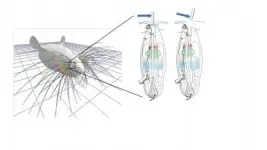(Press-News.org) We know your cat's whiskers are handsome -- but you can't even see the cool part.
The base of the whisker, which is responsible for sending touch signals to the brain, is hidden inside the follicle, a deep pocket that embeds the whisker within the skin. Because this section of the whisker is obscured, understanding precisely how whiskers communicate touch to the brain has been a longstanding mystery.
In a new study, an interdisciplinary team of researchers at Northwestern University has developed the first mechanical simulation of the whisker inside the follicle. By combining their new model with new anatomical observations, the researchers discovered that when whiskers touch an object, they form an "S"-shaped bend within the follicle. By bending into this "S" shape, the whisker pushes or pulls on sensor cells, which then send touch signals to the brain.
The research will be published on April 1, 2021, in the journal PLoS Computational Biology.
The findings could help researchers predict how whiskers activate different sensory cells to influence which signals are sent to the brain as well as help better understand human touch.
"The part of the whisker that triggers touch sensors is hidden inside the follicle, so it's incredibly difficult to study," said Northwestern's Mitra Hartmann, senior author of the study. "You can't measure this process experimentally because if you slice open the follicle, then the damage would change the way the whisker is held. By developing new simulations, we can gain insights into biological processes that cannot be directly measured experimentally."
Hartmann is a professor of biomedical and medical engineering at Northwestern's McCormick School of Engineering, where she is a member of the Center for Robotics and Biosystems. The paper's first author is Yifu Luo, a Ph.D. student in Hartmann's laboratory. Coauthors include Northwestern professor John Rudnicki and Chris Bresee, a former Northwestern Ph.D. student who is now a postdoctoral researcher at the University of California, Davis.
Most mammals use whiskers to explore their environments with the sense of touch. Similar to human hairs, whiskers do not have sensors along their length. Instead, all of their sensors are at the base in the follicle. When an external force bends a whisker, that deformation extends along the whisker into the follicle, triggering sensor cells.
Few previous studies have examined how whiskers deform within follicles in order to make contact with the sensor cells. To better understand this process, Hartmann's team drew on data from experimental studies of whisker follicles.
In addition to finding a signature "S"-shaped bend, the Northwestern team determined this bending profile is likely similar regardless of whether an animal actively touches an object with its whiskers or is passively touched by something external.
"Our model demonstrates consistency in the whisker deformation profile between passive touch and active whisking," Luo said. "In other words, the same group of sensory cells will respond when the whisker is deflected in the same direction under both conditions. This result suggests that some types of experiments to study active whisking can be done in an anesthetized animal."
Although the model is based on experimental data collected from rats, Hartmann believes their findings will likely apply to all mammals. And beyond learning more about our furry friends, this work also could provide new insights into the human sense of touch.
"The sense of touch is incredibly important to nearly everything we do in the world, yet it is very difficult to study touch using hands," Hartmann said. "Whiskers provide a simplified model to understand the complex, mysterious nature of touch."
INFORMATION:
The study, "Constraints on the deformation of the vibrissa within the follicle," was supported by the National Institutes of Health (award number R01-NS093585).
For the first time, researchers have discovered a way to obtain polarity and photovoltaic behavior from certain nonphotovoltaic, atomically flat (2D) materials. The key lies in the special way in which the materials are arranged. The resulting effect is different from, and potentially superior to, the photovoltaic effect commonly found in solar cells.
Solar power is considered a key technology in the move away from fossil fuels. Researchers continually innovate more efficient means to generate solar energy. And many of these innovations come from the world of materials research. ...
Despite a reduction in the total amounts of pesticides used, the toxicity of commonly used pesticides to nontarget species, partially aquatic invertebrates and pollinators, has increased considerably in recent decades, according to a new study analyzing 25 years of pesticide use. This has been driven by the widespread use of highly toxic pyrethroid and neonicotinoid pesticides. The findings challenge claims suggesting that the overall environmental impacts of pesticide use have declined. The impacts of applied pesticides on humans and the environment are often based on comparisons of use rates (e.g., kilograms per hectare) or the total amounts used (e.g., kilograms per year). However, from an environmental perspective, these weight-based ...
Technology can be biased, and its design can disadvantage certain demographic groups. While efforts to address bias and promote fairness in technologies are rapidly growing in a variety of technical disciplines, Achuta Kadambi argues that similar growth is not occurring fast enough for medical engineering. "Although computer science companies terminate lucrative but biased facial recognition systems, biased medical devices continue to be sold as commercial products," writes Kadambi in a Perspective. Bias in medical devices results in undesirable performance variation across demographic groups and can greatly influence health inequality. For example, optical biosensors that use light to monitor vital signs like blood oxygenation ...
In an analysis of thousands of fossil pollen and leaves spanning the Cretaceous-Paleogene (K/Pg) boundary, researchers found that the cataclysmic asteroid impact that resulted in the destruction of nearly 75% of all terrestrial life on Earth drastically restructured tropical forests, setting the stage for the evolution of what has become one of the planet's most diverse ecosystems - the neotropical rainforest. While the end-Cretaceous impact nearly 66 million years ago was catastrophic for terrestrial ecosystems worldwide, its long-term effects on tropical forests have remained a mystery. This is largely due to the lack of palaeobotanical exploration in the region, which has only just begun to provide ...
An increase of dopamine in the brain's striatum triggers auditory hallucination-like experiences in mice, revealing a possible causal role for dopamine-dependent neurological circuits in symptoms of psychosis. These findings from a new study could inform novel targeted approaches to treating those with psychotic disorders, like schizophrenia. Auditory and visual hallucinations - perceptions of hearing or seeing something without observing external sensory stimuli - are central symptoms of psychotic disorders and are thought by some to be caused by excessive dopamine ...
A single "super photon" made up of many thousands of individual light particles: About ten years ago, researchers at the University of Bonn produced such an extreme aggregate state for the first time and presented a completely new light source. The state is called optical Bose-Einstein condensate and has captivated many physicists ever since, because this exotic world of light particles is home to its very own physical phenomena. Researchers led by Prof. Dr. Martin Weitz, who discovered the super photon, and theoretical physicist Prof. Dr. Johann Kroha have returned from their latest "expedition" into the quantum world with a very special observation. They report of a new, previously ...
(Santa Barbara, Calif.) -- Despite the fact that our planet is mostly ocean and human maritime activity is more intense than it has ever been, we know remarkably little about the state of the ocean's biodiversity -- the variety and balance of species that support healthy and productive ecosystems. And it's no surprise -- marine biodiversity is complex, human impacts are uneven, and species respond differently to different stressors.
"It is really hard to know how a species is doing by just looking out from your local coast, or dipping underwater on SCUBA," said Ben Halpern, a marine ecologist at the Bren School of Environmental Science & Management at UC Santa ...
The humble lab mouse has provided invaluable clues to understanding diseases ranging from cancer to diabetes to COVID-19. But when it comes to psychiatric conditions, the lab mouse has been sidelined, its rodent mind considered too different from that of humans to provide much insight into mental illness.
A new study, however, shows there are important links between human and mouse minds in how they function -- and malfunction. Researchers at Washington University School of Medicine in St. Louis devised a rigorous approach to study how hallucinations are produced in the brain, providing a promising entry point to the development of much-needed new therapies for schizophrenia.
The study, published April 2 in ...
Tropical rainforests today are biodiversity hotspots and play an important role in the world's climate systems. A new study published today in Science sheds light on the origins of modern rainforests and may help scientists understand how rainforests will respond to a rapidly changing climate in the future.
The study led by researchers at the Smithsonian Tropical Research Institute (STRI) shows that the asteroid impact that ended the reign of dinosaurs 66 million years ago also caused 45% of plants in what is now Colombia to go extinct, and it made way for the reign of flowering plants in modern tropical rainforests.
"We wondered how tropical rainforests changed after a drastic ecological perturbation such as the Chicxulub impact, so we looked for tropical plant fossils," said Mónica ...
LA JOLLA--(April 1, 2021) Neurons lack the ability to replicate their DNA, so they're constantly working to repair damage to their genome. Now, a new study by Salk scientists finds that these repairs are not random, but instead focus on protecting certain genetic "hot spots" that appear to play a critical role in neural identity and function.
The findings, published in the April 2, 2021, issue of Science, give novel insights into the genetic structures involved in aging and neurodegeneration, and could point to the development of potential new therapies for diseases such Alzheimer's, Parkinson's and other age-related dementia disorders.
"This research shows for the first time that ...




